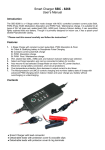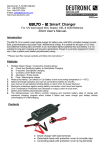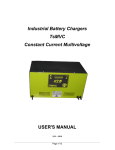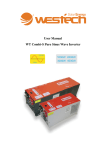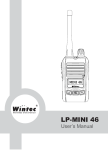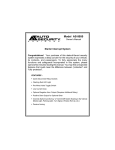Download Smart Charger SBC - 8168 User's Manual
Transcript
Smart Charger SBC - 8168 User’s Manual Introduction The SBC-8168 is a Switch Mode Battery Charger with MCU controlled charging. Maximum charge is achieved through 4 stage charging (Precondition, Bulk, Absorption and Float charge stages). This charger is suitable for 5AH-120AH 12V lead acid batteries including GEL and AGM. Another excellent feature is a sealed splash and dust proof IP-55 rated polycarbonate casing. **Please read this manual carefully and follow the instructions** Features 1. 2. 3. 4. 5. 6. 7. 8. 4 Stage Smart Battery Charger. A. Pre charge – Battery analysis. B. Bulk - Constant Current charge. C. Absorption – Constant Voltage Pulse charge. D. Float – Maintenance charge. Motorcycle, Car, and Low Temperature (< 10°C) charge modes. Easy one button charge selection. Can be permanently connected to the battery. Electronic Output short circuit and reverse polarity protection. Splash and dust proof IP-55 construction with poly-carbonate casing. Over-Temperature Protection. Smart battery charging is achieved with internal Microcomputer Unit (MCU). Condition of the battery is analyzed before charging starts and is monitored constantly during charging. Contents ● Smart Charger with lead connector ● Detachable leads with protection cover & crocodile clips ● Detachable leads with protecion cover & ring terminals Warning : ● ● ● ● ● ● ● ● ● ● ● ● ● ● ● ● This charger is designed for only charging 12V lead acid batteries of 5 to 120Ah. Do not use this charger for any other purpose For indoor use only Explosion hazard: A battery being charged could emit explosive gases. Avoid smoking or open sparks or naked flames in the vicinity of the battery. Do not cover the charger while charging, allow good ventilation to the charger . Danger of chemical burns: battery acid is highly corrosive. If your skin or eyes come into contact with acid, immediately rinse the affected part with excessive wate and seek medical attention. Do not charge a frozen battery. Do not charge a damaged battery Disconnect battery from charger which is not connected to AC mains socket. Do not recharge non-rechargeable batteries When install in caravans and similar vehicles, the connection to the AC mains is to be in accordance with the national wiring regulations. If the cord is damaged, the charger should be scrapped . Check charger has reached Float Mode if it is intended to leave charger connected for a long period of time . As all batteries fail eventially. A battery that fails during charging is usually taken cared of by the charger’s protection controls. However, accident can happen and do not leave charger in operation for week without checking up on it frequently. When charging mounted automotive battery. ● The battery terminal not connected to the chasis must be connected first. ● Then make the next connection to the part of chassis away from the fuel line or Battery. ● After charging, disconnect the battery charger from the supply mains.Then remove the chassis connection first follow by battery connection. Operation Charging Mode Motorcycle Mode e 14.4V / 1.5A max. Battery capacities of 5 - 14 Ah Car Mode f 14.4V / 5A max Battery capacities of 16 - 120 Ah Low Temperature Charging Mode g 14.7V / 5A max Battery capacities of 16 – 120Ah Recommended for temperature below 10°C Not recommended for long term maintenance when temperature exceeds 10°C at times Plug in the charger to AC mains (100 - 240V) wall socket. The indicatiors light up one by one as charger goes through a series of self checks. Then all lights are on together and off to indicate the end of checks except the operation “Standby” indicator. Connect the red output lead to the positive terminal of the battery and the black lead to the negative teminal. The “Standby” blinks to indicate that charger is ready for selection of Charge Mode. User has 2 minutes to select the desired Charge Mode. If no selection is made, the battery charger will revert back to its last used Charge Mode. Select the appropiate Charge Mode by pressing the Mode button one or more times within 2 minutes. The Charge Mode indicator changes with each press “Motor Cycle” → “Car “ → “Snow” → “Motor Cycle” in cycle. The Mode button will also be locked in 10 seconds after selection of Charge Mode. If no pressing on the Mode key has been done after 2 minutes, the charger will automatically enters into the last selected charging mode. Display Indications Standby Mode d Steady light on : AC mains connected but charger is not yet connected to battery. Blinking light on : Battery is connected, 2 minutes to select charge mode before charger enters to last selected Charge Mode. Check Mode h Steady light on : For a few seconds initially for normal battery, charger checking battery. Steady light on : For longer time, charger in *desulphate charging. Blinking light on : When connected to battery showing the battery is not suitable for charge. Blinking light on : After unit in Charging Mode for long time (max. 40 hrs.), or desuphating charge (max.8 hrs.), battery still cannot hold charge or cannot be desuphated. Remove battery . Charging Mode i Steady light on : Charging in progress (desulphate and bulk or absorption charge stage) Float / Maintenance Charge Mode j Steady light on : Battery is fully charged and Charger in Float / Maintenance Pulse Mode Alarm k The blinking alarm indicates charging fault, check following faults. Output connectors short circuit Output connectors in wrong polarity Over temperature Protection activated, charging has stopped. Check Mode and Normal Charging The Charger first checks the battery’s condition , for normal battery this indication extinguishes after a few seconds and charger enters into “Charge Mode” and finally to the “Float/maintenance Mode” when the battery is fully charged. Charging Stages Bulk : This charges the battery up to about 80% full. The charger delivers max 5A current for Car and Low temperature mode , 1.5A for Motor Bike Mode until the battery voltage rises to a set value . There is a thermal control in gradual decrease of charging current at high operation temperature for the Car and Low Temperature Mode. Absorption : PWM charges to 100%. The terminal voltage is kept constant at set level. Battery charger delivers current pulses to the battery in varying pulse periods. When the rise time of pulses decreases to a set value, charger switches to Float Mode. The maximum total charging time of Bulk and Absorption is 40 hours at which the charger will shut down. Float : PWM maintenance charging and cycle charging In this mode the charger does not deliver current when battery voltage is above a set voltage. When battery voltage drops below the set voltage, charger will deliver small current until the battery voltage rises to about 13.5V. Then the maintenance charging cycle repeats. In the case of battery voltage drops more than 12.2V due to external load or otherwise , the charger will start a new charging cycle of Bulk, Absorption and Float. Check Mode and Desulphate Charging The desulphate charging can recondition only slightly sulphated battery. A. In the case the “Check Mode” indication is lit longer, the charger is in desulphate charging. After some time, if desulphation of the battery is successful, the charger will switch to normal charging and the “Check Mode” is extinguished. B. If the desulphate charge fails to recondition the battery after some time, the “Check Mode” blinks. The battery should be replaced. The maximum desulphate charging time is 8 hours. Check Mode and Unchargeable battery A. If the Check Mode blinks before or after pressing the Mode button then the battery is not suitable for charging. Check the battery connections, clean battery terminals to double confirm if the battery is not really suitable for charging. B. The Check Mode also blinks after 40 hours in Bulk and or Absorption Stage charging until battery is removed. This safety time feature is to avoid charging faulty battery which cannot hold charge. Alarm and Faults The blinking Alarm indicates faulty connections or charge condition so that charger does not give any output power. Once the fault has been corrected charger will continue to operate normally. A. Wrong connection of Positve and Negative terminal will cause “Alarm” to blink. B. Shorting the output cable terminals (crocodile clamps or ring connectors) C. Over Temperature Protection has been activated charging has stopped. Interrupting the charging process When there is a power outage, the battery charger will resume charging at its last selected Charging Mode (motorcycle, car, Low Temp.) upon the return of mains AC power. The charger automatically completes the charging process when the charging end voltage is reached and switches to float / maintenance charge mode. Specifications AC Input 100-240V, 50/60Hz~, 1.5A MAX. Maximum Output Charging Current 5A Max. Power 70W Efficiency >78% Maximum Output Charging Current for Car/Low Temp. Mode 5A Maximum Output Charging Current for Motorcycle Mode 1.5A Absorption Voltage (Motor cycle/Car Mode) 14.4V Absorption Voltage (Low Temperature Mode) 14.7V Construction IP-55 (splash-proof) , poly-carbonate casing Accessories Detachable leads with crocodile clips and leads with ring terminals Protection: Overload, Short Circuit, Over Temperature, Reverse Polarity, No Spark For Battery Connected and Short Output. Cooling System Natural Convection Approvals CE EN 55014 EN 60335 EN 62233 Dimensions (LxWxH) 150x60x30mm *SPECIFICATIONS ARE SUBJECT TO CHANGE WITHOUT PRIOR NOTICE* REV.1.4 2010/06 7673-8168-2673





